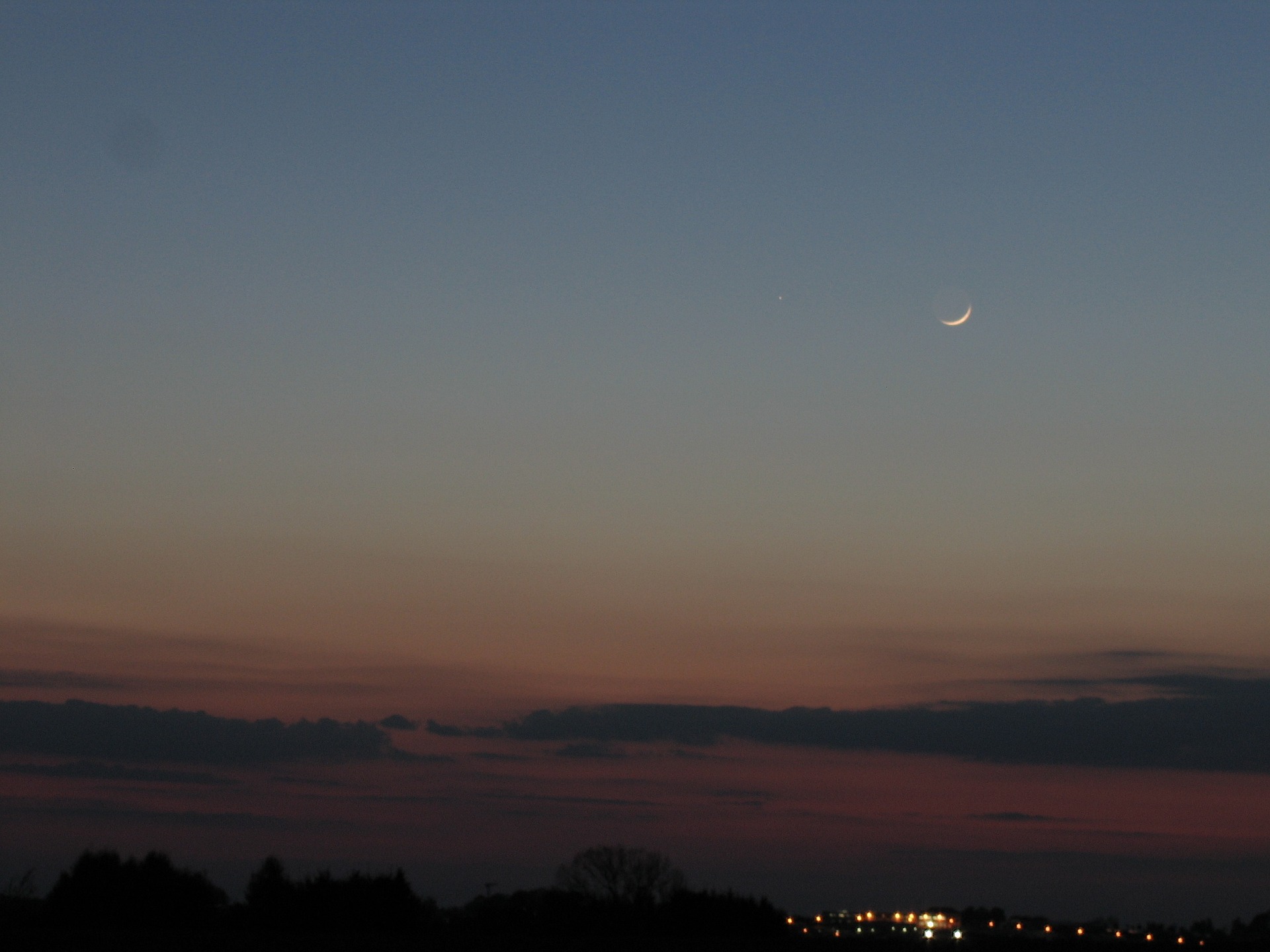Venus makes a grand entrance in April. It shines so brightly that it can be mistaken for a spy balloon, for example. Stargazers have a rare chance with another planet: Mercury can be seen in the evening. And from the middle of the month, the meteors of the Lyrids appear.
With the change of the clocks to daylight saving time, Venus is the first star to appear in the western sky in the last evening twilight. It can be seen in April, long before the other stars and planets become visible. Venus is the highlight of the evening sky. It shines so conspicuously that some do not recognize it as a planet but suspect a spy balloon or something else.
Venus climbs the northernmost districts of the zodiac and passes through the so-called Golden Gate of the ecliptic, formed by the two open star clusters, Hyades and Pleiades. On April 10, Venus passes three degrees south of the Pleiades and on the 20th passes Aldebaran in Taurus far to the north.
Rare Mercury Opportunity
The sets of our inner neighbouring planet always occur later. On the 1st, Venus sets half an hour before midnight, and at the end of the month, not until half an hour after midnight. The crescent of the waxing Moon passes by Venus on the 23rd. This should make for an interesting sight in the sky.
Mercury can also be seen in the evening in April, which is never the case elsewhere in the year. If you have never seen the smallest planet in the solar system with your own eyes, you should take the opportunity. The most favourable time to observe Mercury are the days from April 3 to 13. Around 8:30 pm, the nimble planet becomes visible low in the western sky at dusk. Soon after, it disappears into the horizon haze. By the 13th, its sets are delayed to 10 pm. Mercury will last be visible to the naked eye under good viewing conditions on the 16th.
Mars can be seen high in the western sky after dark. Our outer neighbour planet wanders through the constellation Gemini. However, its shining time is over; its brightness decreases slightly. On the 26th, the Moon visits the Red Planet in the First Quarter.
Saturn in the morning sky
Saturn gradually appears in the morning sky. From the middle of the month, you can peek for the ringed planet with a chance of success. Saturn moves through the constellation Aquarius. The ringed planet rises shortly before 6 am on the 1st and a few minutes after four at the end of April. Jupiter stays in the daytime sky and remains unobservable at night.
The Easter full moon shines on the 6th in the constellation Virgo near its main star Spica. At 367,968 kilometres, the Moon is close to Earth on the 16th. On the 20th, the new moon phase occurs at 6:13 am. The dark new Moon covers the sun. A ring-shaped total solar eclipse occurs, which is not visible from Europe. Because the moon’s shadow sweeps over parts of the Indian Ocean, Australia, and Oceania as well as parts of the Pacific and touches Antarctica. On the 28th, 404,299 kilometres separate the Moon from us at a distance from Earth.
After nightfall, the Big Dipper can be seen high above our heads, almost at the apex or zenith of the celestial vault. Starting from the Big Dipper, one quickly finds Polaris. One extends the distance between the two back box stars about five times in the bending direction of the drawbar. Then you will find Polaris, also known as the North Star. It is located very close to the north celestial pole, around which the celestial vault with all the stars rotates daily. Polaris is not the brightest star in the sky. Its brightness is similar to the brightness of the wagon stars, which is why it is easy to see. The pole star helps to find the cardinal points.
The middle star in the drawbar of the Big Dipper is called Mizar and serves as an eye tester. Those with normal vision should see a faint star next to Mizar, called Alkor or the Little Rider. For Alkor rides, as it were, on the drawbar of the Big Dipper.
Like a giant index finger, the tiller of the Big Dipper points to a bright orange star in the eastern sky. Arcturus, the Bear Keeper, is the shining star in the image of the Boat, the Cattle Herder. Arcturus is 37 lightyears away from us. The Bootes drive the seven chariot stars around the celestial pole like a shepherd drives the oxen around the globe.
Leo dominates the southern sky. It is the leading constellation of the spring sky. A large trapezium of stars marks the torso of this regal beast, and a small, superimposed trapezium keeps the head with its mane. The main star of the lion is called Regulus, which means little king. The sun passes by it annually on August 23. This is because Leo is one of the 13 zodiacal constellations. Regulus is a bluish, hot sun 77 light years away.
The constellation Virgo has risen in the southeast with its bluish sun Spica. With Spica, the spring triangle is now complete. At 260 lightyears, Spica is the most distant of the three stars in the Spring Triangle, including Arcturus and Regulus.
The winter constellations have largely cleared the field. Orion has set. Also, Sirius has already left the celestial stage. Deep in the southwest, Prokyon in the Small Dog reminds me of past winter days. Still relatively high in the west is the pair of brothers, the twins. The bright Capella in the Fuhrmann twinkles in the northwest.
From April 16 to 25, the meteors of the Lyrids appear. The radiant point of this stream lies in the constellation Lyra, about seven degrees southwest of Vega, the main star of Lyra. The maximum Lyrid activity is expected during the night of April 22-23, with about 20 shooting stars per hour. The meteoroids dip into Earth’s atmosphere at speeds of about 50 kilometres per second and burn up. The best observation time is the hours after midnight.
The sun rises higher and higher in the zodiac. On April 19, it moves from the constellation of Pisces into Aries in the morning. One day later, it enters the zodiac sign Taurus. Its noon altitude increases by ten degrees, and the length of the day increases by one and three-quarter hours.
- Source: ntv.de/picture:
This post has already been read 3071 times!



